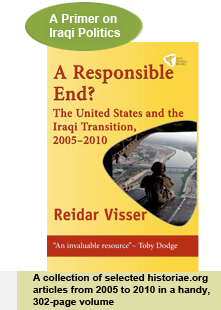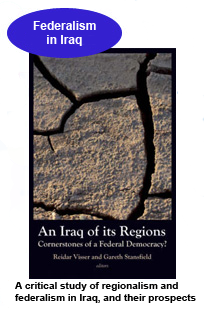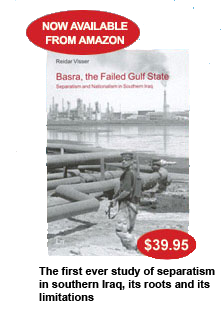



| Main | |
| Documents & images | |
| Links | |
| Contact | |
 | |
| amazon.com |

|
|
|
amazon.com
amazon.co.uk |
|

|
|
|
amazon.com
amazon.co.uk |
|
The Map of Electoral Coalitions South of Baghdad Is Taking Shape
By Reidar Visser (www.historiae.org)
31 October 2008
After a long series of extensions, it now seems as if the final deadline for forming coalitions for the next local elections in Iraq will be on 2 November 2008. The first announcement of coalitions among the Shiite Islamist parties is one of the indicators that suggest the coalition-forming process could be coming to an end.
The most newsworthy feature of the updated coalition list is that the main Shiite Islamist parties in the Maliki government are subdivided into two camps, “The List of the Martyr of the Mihrab and the Independent Forces”, and “The Alliance of the Rechtsstaat” (Itilaf dawlat al-qanun – perhaps it could be called the Rule of Law Alliance in English). This could be a step towards a formalisation of the growing tension between the alliance partners of Islamic Supreme Council of Iraq (ISCI) and Nuri al-Maliki’s Daawa party, which form the nuclei of the two new lists. ISCI’s list is named after the late Muhammad Baqir al-Hakim (Shahid al-Mihrab), and also contains a reference to independents. However, on closer inspection, this seems like old wine in a new bottle: apart from ISCI, the list consists of familiar names – Badr, “Hizbollah in Iraq” and the Sayyid al-Shuhada movement, all frequently accused of having particularly close links to Iran. The only “independent” element – “The Independent Society for the Sake of Iraq” – is in fact the personal creation of ISCI member Adil Abd al-Mahdi.
The Daawa coalition, on the other hand, has scored one important victory: it now includes the independent list of Husayn al-Shahristani alongside the two main factions of the Daawa. ISCI has long attempted to portray itself as a party with particularly close ties to the Grand Ayatollah Ali al-Sistani (who, for his part, has failed to reciprocate); the decision by someone like Shahristani to join the Daawa coalition rather than ISCI must be something of a defeat for them, as the Iraqi oil minister is thought to have good relations with Sistani. Still, this merely emphasises a division that dates back at least to February, when Maliki and independents of the United Iraqi Alliance (UIA) were at odds with ISCI over the provincial powers law. Other new elements in the Daawa coalition are smaller local parties from Dhi Qar and Qadisiyya as well as some Turkmen and Fayli Kurd parties.
There still seems to be some competition for the UIA independents though. The blocs associated with Qasim Dawud and Ibrahim Bahr al-Ulum have formed an independent coalition at the national level (i.e. at the national office of the elections commission), but at the same time they also participate in various local lists. In the case of Dhi Qar they have joined with other independents, but in Diyala ISCI has managed to get these two blocs on its own local list – the National Alliance of Diyala. More such local alliances could materialise in the final days before the deadline and thus complicate the map (ISCI is probably negotiating fiercely for a Basra coalition, for example), but the early crystallisation of two distinctive Shiite coalitions does suggest that there could be a degree of substance to the rumours about an intra-Shiite power struggle inside the Iraqi government. So far, the only possible sign of a tribal awakening in the south being reflected in coalition politics is the emergence of a list that groups together Abd al-Karim Mahud al-Muhammadawi’s “Hizbollah of Iraq” with smaller parties with headquarters in Basra and Samawa.
Copyright © 2005-2008 historiae.org & Reidar Visser
This document or quotes from it may be freely reproduced as long as www.historiae.org is credited as the original source.
